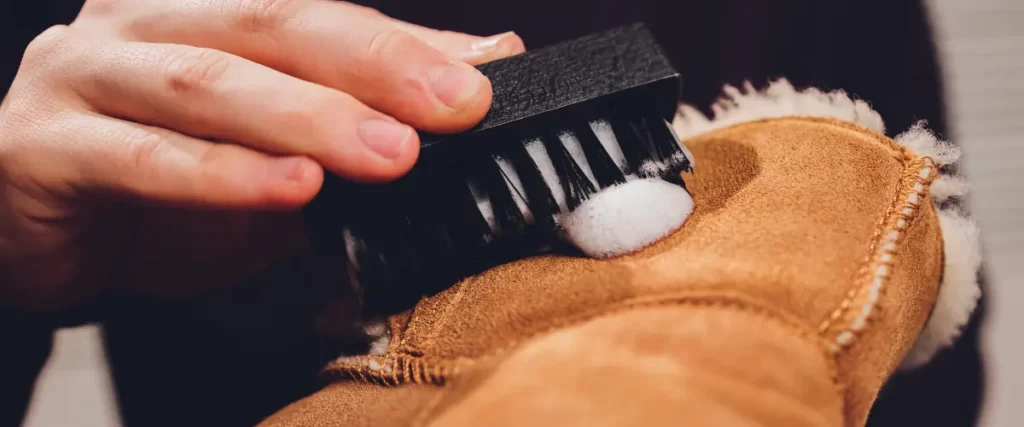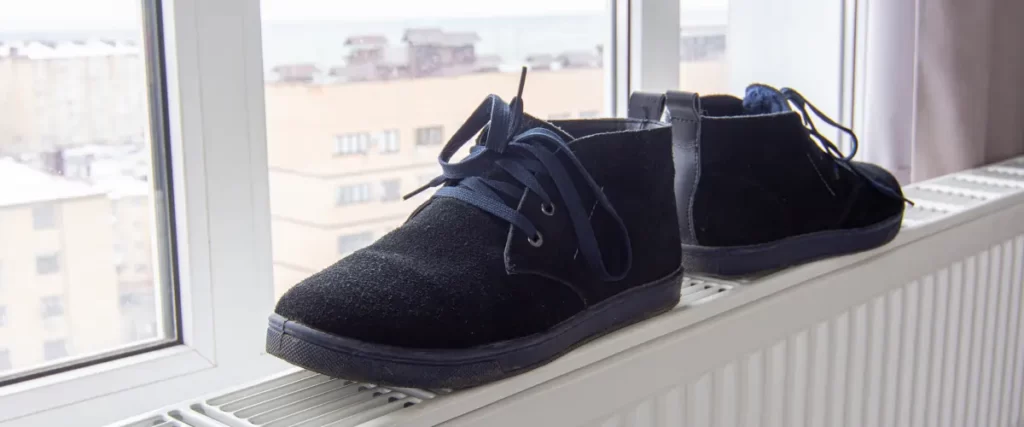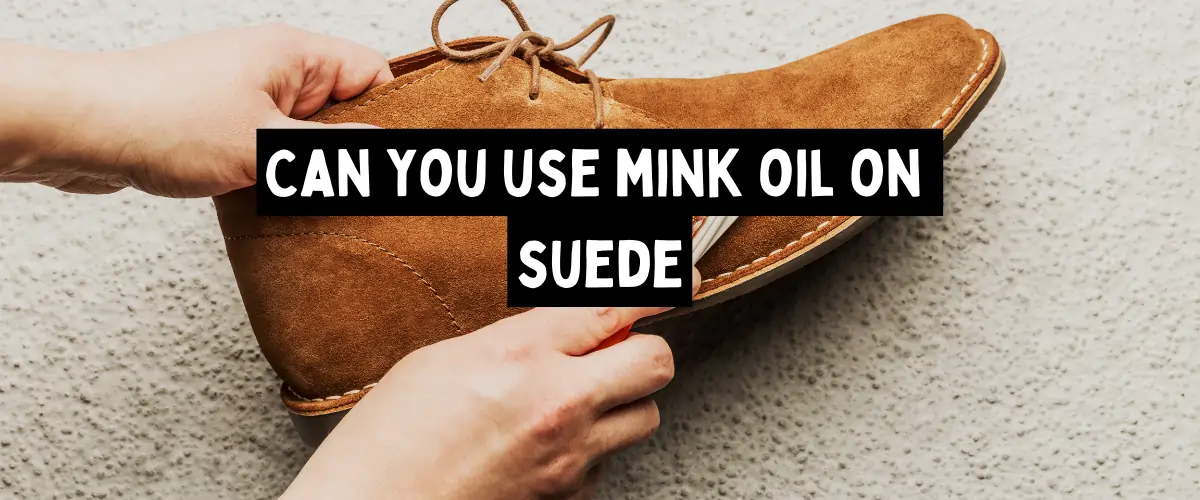Last Updated on December 21, 2023
Mink oil, widely revered for its conditioning properties on leather, often sparks curiosity when it comes to suede application. The short answer is yes, mink oil can be applied to suede. However, it’s crucial to proceed with caution. The application can enhance suede’s resistance to moisture and give it a richer color, but it can also alter the suede’s distinct texture and appearance. It’s always recommended to test on a small, inconspicuous area first to ensure the desired effect.
Given the significance of your suede items, whether it’s a pair of stylish boots or an elegant handbag, it’s essential to be well-informed before attempting any treatments. Let’s delve deeper into the intricacies of using mink oil on suede and explore its pros, cons, and recommended practices.
Understanding the Composition of Suede
Suede, a staple in fashion and upholstery, is distinguished by its unique texture and soft hand feel. But what makes suede different from other types of leather? To truly appreciate the beauty and unique qualities of suede, one needs to delve deeper into its composition and creation process.
Origin of Suede
Suede is derived from the underside of animal skins, primarily from lamb, although goat, pig, calf, and deer are also used. Unlike traditional leather, which uses the exterior skin side, suede uses the interior, resulting in its signature napped finish.
The Napped Finish
The term ‘nap’ refers to the raised, fibrous surface that gives suede its soft and velvety texture. It’s this texture that sets suede apart from other leathers. The nap is created through a process called ‘abrading’ or ‘buffing.’ Here, the inner surface of the leather is meticulously rubbed to raise the fibers, producing suede’s characteristic soft and fuzzy finish.
Tanning Process
The process of turning rawhide into suede involves tanning. The tanning process stabilizes the proteins in the skin, ensuring the leather doesn’t rot or degrade. While there are various tanning methods, the chosen process can influence the texture, color, and durability of the suede.
Dyeing and Coloring
Suede is often available in a wide spectrum of colors. It’s dyed using specific dyes that penetrate the fibers, ensuring even coloring while maintaining the material’s softness. The dyeing process can also influence the final feel of the suede, making it softer or slightly stiffer.
mink oil on suede Basics
What is Mink Oil? Derived from the fatty layer under the skin of minks, mink oil has been a go-to product for leather enthusiasts for years. Rich in unsaturated fatty acids, it has remarkable moisturizing and protective properties which can prolong the look of your expensive work boots.
Benefits of Mink Oil on Leather
Mink oil serves several purposes when applied to leather goods:
Moisturization
Mink oil is a wonder when it comes to moisturizing. Leather, in its essence, can dehydrate and lose its essential oils over time. Mink oil steps in to replenish this moisture, ensuring your leather stays soft and flexible.
Protection
Applying mink oil forms a barrier on the leather’s surface. While it won’t make your leather items waterproof, it does impart a level of water resistance, which is invaluable for outdoor leather gear.
Enhanced Durability
Regular application can significantly extend the lifespan of leather items. By warding off drying and potential cracking, mink oil maintains the structural robustness of leather, staving off wear and tear.
Flexibility
No one likes stiff leather shoes or gloves. Leather needs to flex for comfort. Mink oil ensures leather remains supple, preventing it from becoming rigid and unwieldy.
Improved Appearance
Want to make your leather shine? Mink oil can offer a rich sheen to leather items, ensuring they always look their best.
Prevention of Cracking
Cracking is a leather owner’s nightmare. Dry leather is prone to this issue, but mink oil ensures your leather remains hydrated and crack-free.
Restoration
Leather items might fade over time, especially with exposure to elements. Mink oil can assist in restoring, or at times evening out, the original color, giving leather items a fresh look.
Natural Ingredient
For the eco-conscious, mink oil stands out as a natural product. It often lacks harmful chemicals that could damage leather or be detrimental to the environment.
The Great Debate: Mink Oil on Suede
Pros of Using Mink Oil on Suede
On the surface, mink oil appears to be a match for suede. Some potential benefits include:
Enhanced Water Resistance
One of the immediate benefits of mink oil is its ability to impart a degree of water resistance to suede. While it doesn’t render suede completely waterproof, it can make it more resilient against occasional splashes or light rain. Learn here if rain work boots are helpful in snow.
Conditioning and Softness
Suede, being leather’s underside, can sometimes become dry or lose its suppleness. Mink oil can help maintain or even enhance the softness of suede, making it feel luxurious to the touch.
Color Depth
For darker suede items, mink oil has the potential to enrich the color, making it appear more vibrant. This can be especially useful for suede items that have started to look a tad faded or worn out.
Natural Protection
Mink oil acts as a protective barrier against some elements. Besides water, it can offer limited protection against certain stains or pollutants, ensuring your suede items remain clean for longer.
Enhanced Longevity
When applied appropriately and in moderation, mink oil can contribute to the overall longevity of suede items, ensuring they serve you well for years to come.
Cons and Concerns of Using Mink Oil on Suede
However, the relationship between mink oil and suede isn’t all rosy:
Risk of Darkening
One of the primary concerns is the potential darkening of suede. Mink oil, when absorbed, can alter the original color of suede, sometimes making it darker and occasionally in an uneven manner. This change can be particularly pronounced in lighter shades of suede.
Texture Alteration
The distinct napped finish of suede is what gives it its luxurious feel. However, mink oil can sometimes saturate the suede in such a way that it clogs or clumps this texture, making it feel less soft or velvety to the touch.
Potential for Over Conditioning
While conditioning is generally good, there’s a thing as too much of it. Over-conditioning with mink oil can make suede overly soft, potentially compromising its structural integrity or leading to premature wear and tear.
Residue Build-up
Improper or excessive application of mink oil can result in a residue build-up on the suede’s surface. This not only affects the appearance but can also attract dirt and dust more easily.
Potential Long-Term Damage
Mink oil, if not absorbed fully, can trap moisture within the suede. Over time, this can create an environment conducive to mold growth or lead to the premature deterioration of the suede.
Limited Breathability
Leathers, including suede, are known for their breathability. However, a heavy application of mink oil can reduce this breathability, making items like shoes less comfortable as they might trap sweat or heat.
Alternative Suede Care Recommendations
Given the mixed reviews on using mink oil on suede, it might be wise to consider alternatives:
Suede is undeniably stylish and luxurious, but it demands particular attention to ensure its beauty and integrity remain uncompromised. While mink oil has its pros and cons, several alternative treatments and best practices can help maintain and protect your suede items. Here’s a look at some recommended suede care approaches:
Suede Protector Sprays
One of the first lines of defense for suede items is a quality protector spray. These sprays are formulated to repel water and stains without affecting the suede’s natural texture or color.
Suede Brushes
To maintain the iconic nap of suede and remove superficial dirt, a specialized suede brush is essential. These brushes often have soft bristles designed specifically for the delicate surface of suede.
Suede Erasers
For minor blemishes or scuffs on suede, a suede eraser can be a lifesaver. These are designed to lift away dirt and restore the nap without causing any damage.
Cornstarch or Talcum Powder
If you accidentally spill oil or another greasy substance on suede, immediately sprinkling a bit of cornstarch or talcum powder can absorb the spill. Let it sit overnight and gently brush off the residue the next day.
Avoiding Direct Heat
Never place wet or damp suede near direct heat sources like boot dryers, radiators or heaters. Direct heat can cause the suede to shrink or warp. Instead, let suede items air dry naturally.
Regular Dusting
To prevent the accumulation of dust or dirt, which can dull the appearance of suede, regularly give your items a gentle brush or shake.
Storage
When storing suede items, especially garments, ensure they’re kept in a well-ventilated space. Using cloth bags instead of plastic can allow the suede to breathe and prevent any potential moisture buildup.
Consult a Professional
For significant stains or damages, it’s often best to consult a professional suede or leather cleaner. Their expertise can help restore your suede items without risking further damage.
How to apply mink oil to suede?

Taking care of suede is an art, especially when you’re looking to venture beyond conventional methods. Mink oil, commonly heralded for its benefits on leather, can also be used on suede, albeit with caution. As a work boot expert, I’ve witnessed firsthand the transformative effects of mink oil on various materials. If you’re considering using mink oil on your suede work boots or any other suede item, here’s a step-by-step guide to ensure the best results.
Step 1: Clean Your Suede Item
Before you begin the application of any product, it’s crucial to start with a clean slate.
Remove Loose Dirt:
Gently tap your suede item to shake off any loose dirt or debris. For boots, it’s helpful to knock the soles together.
Use a Suede Brush:
Brush your suede using gentle strokes with a specialized suede brush. This will help lift the nap and remove any superficial dirt or dust.
Step 2: Apply Mink Oil
Once your suede is cleaned, you’re ready to apply the mink oil.
Test a Small Area:
Always start by testing a small, inconspicuous area. Mink oil can darken suede, and it’s essential to ensure you’re happy with the result before applying it fully.
Use a Soft Cloth:
Dab a soft, clean cloth into the mink oil. You don’t need much; a little goes a long way.
Gentle Application:
Rub the oil onto the suede in a circular motion, ensuring even coverage. Remember, moderation is key. Over-saturation can lead to undesired effects.
Step 3: Brush the Suede

Once the mink oil is applied, it’s time to re-lift the nap of the suede.
Wait a Moment:
Let the mink oil sit for a few minutes, allowing it to penetrate the suede’s surface.
Gentle Brushing:
With your suede brush, gently brush your item. This step helps ensure an even distribution of the oil and maintains the suede’s distinct texture.
Step 4: Air Dry

The final step is crucial for the suede’s longevity and appearance.
Natural Drying:
Place your suede item in a well-ventilated area, away from direct heat sources. Let it air dry naturally. This could take a few hours to overnight, depending on the item’s size and the amount of mink oil applied.
Final Brush:
Once your item is completely dry, give it one last gentle brush to ensure the nap is uniform and soft.
While mink oil can offer benefits to suede, always approach with caution. It’s a method that can offer protection and conditioning, but the key lies in the application’s precision. For your work boots or any suede item, knowing the right techniques ensures longevity and maintained aesthetics.
Conclusion
While mink oil offers a plethora of benefits for full-grain leather, suede, with its unique properties, requires a more careful approach. Before opting to use mink oil on suede work boots, consider the potential downsides and weigh them against the benefits. It’s always best to test on a small, inconspicuous area first or stick to products specifically designed for suede care.
Stay curious, stay informed, and above all, take care of those boots that take care of you!
FAQs
Can you oil suede shoes or boots?
Yes, you can oil suede shoes or boots, but it’s essential to do so with caution. Oiling can provide certain protective qualities, but it might also change the texture and appearance of the suede. Always test a small, inconspicuous area first.
What does mink oil do to suede?
Mink oil acts as a conditioner for suede, helping it remain soft and supple. It can impart a certain degree of water resistance and can also deepen the color of the suede, giving it a refreshed appearance. However, it can sometimes darken suede or alter its texture, so it’s vital to be aware of these potential changes.
Does mink oil darken suede?
Yes, mink oil has the potential to darken suede, especially lighter shades. This is one of the primary reasons it’s always recommended to test on a small area first. If you’re seeking to enrich or darken the color of your suede item intentionally, mink oil can be beneficial.
Is there a mink oil spray for suede?
While traditional mink oil is typically in a semi-solid form, there are some mink oil sprays available on the market. These sprays are often combined with other ingredients and can offer a more even application. However, always check the product’s suitability for suede before use.
Is oiled suede waterproof?
Oiling suede, whether with mink oil or another product, can provide water resistance, but it doesn’t make the suede entirely waterproof. It’s better equipped to handle light splashes or rain but isn’t designed for prolonged exposure to water.
Can suede be conditioned?
Absolutely! Suede can and should be conditioned to maintain its softness, texture, and appearance. While mink oil is one option, there are numerous suede-specific conditioners on the market designed to nourish the material without altering its unique characteristics.
I’ve already applied mink oil to my suede boots, what now?
Don’t panic! Regularly brushing the suede can help redistribute or remove excess oil. If you notice any discoloration, consult a professional for further care.
Mark Walter is an accomplished researcher and writer with a wealth of knowledge and experience in the world of work boots. His expertise in this field is unmatched, having worked in a variety of industries and work environments. Mark's writing is clear and concise, making him an ideal source of information for anyone looking to learn more about the importance of selecting the right work boots for the job.

















